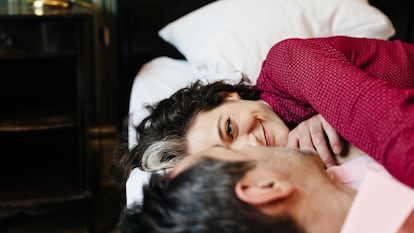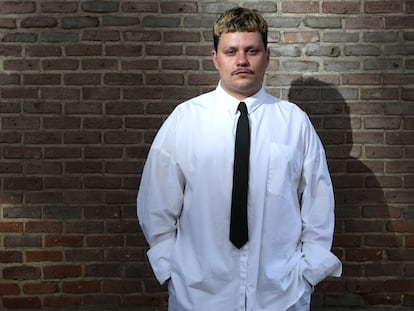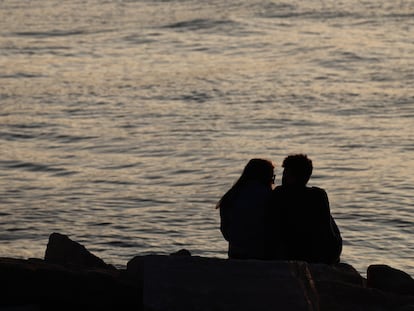When is the right time to decide to open a relationship?
What are the signs that couples are in a position to do so? Are open relationships for everyone? Two experts answer the most common questions people have about taking this step

Will and Jada Pinkett Smith are a well-known example of a couple who has been together for decades and decided to establish an open relationship. According to a Journal of Sex and Marital Therapy study, one in five adults has practiced consensual non-monogamy at some point in their lives, but the data indicate that the vast majority of people still prefer traditional relationships. The lack of knowledge about open relationships means that many people still continue to speak of infidelity when talking about a non-monogamous relationship. “It has more to do with our belief system and that is difficult to change,” says Cecilia Figlioli, the co-founder of Open Relationships, an organization that disseminates information about and raises the visibility of non-monogamy through meeting spaces, training and studies on the subject.
When is the right time to establish an open relationship?
The first thing to keep in mind is that not everyone is ready for an open relationship. Psychologist and sexologist Arola Poch, an expert in relational diversity, explains to S Moda that “there are people who continue to see [open] relationships from the [perspective of] prejudice (‘it’s cheating,’ ‘there is no fidelity,’ ‘they do not love each other’...) and, clearly, you cannot open a relationship from that perspective. There are those who may want to have an open relationship, but their relationship does not have the good foundation that it needs, and…there are [also ]those who may believe that it is a good idea in theory but cannot put it into practice because of their ingrained notions about monogamy, fidelity and relationships,” she says. In fact, as Lídia Manot, the author of Loving Beyond Monogamy, points out, there are many people who don’t even feel that impulse. “There are those who, because of old traumas or because of the difficulty they feel in connecting with someone, think that an open relationship is not for them and believe that they really need the peace of mind that comes from having only one sex-affective bond. I don’t think there is a right or wrong way to relate, and I don’t think open relationships are for everyone. Whether or not you are ready to do it is another question. Feeling fear and jealousy does not make you less ready. Ideally, you inform yourself [about it], analyze yourself and explore the subject, because maybe you are [ready] and just need the necessary tools and to understand the process in a healthy and organic way,” she says.
When is it a good idea to open a relationship if you want to do so? “When both people are clear that they want to explore… sexual non-exclusivity and when the relationship is [in a] good [place]—there aren’t any conflicts and there’s a good foundation of communication, trust, honesty and mutual understanding. It is better to prepare the relationship first and then open it, than to open it and then prepare. Inevitably, when opening a relationship, unforeseen situations will arise, but the foundation must be there,” says Poch. According to Lídia Manot, a coach, writer and educator of Ethical Non-monogamy and Polyamory, when establishing an open relationship, it is important to be clear about where to start. “It is a personal process that requires unpacking. I would say that opening a relationship is born from more intense questions and asking ourselves what we want to experience personally and in a couple. There will be people who use [an open relationship] to avoid the decision to leave [their partner], but I know of others who feel good, and that feeling gives them the confidence to take the next step. For example, signs that might indicate that establishing an open relationship is a good idea include one of the parties recognizing that what they feel is not a one-off, but [rather] that they have been feeling for some time that they do not fit the traditional model of a couple and that no matter how much they love a person, they never stop feeling the desire to connect with other people in a very broad sense (not necessarily in a sexual way). When we perceive that our life and our experience of how relationships should be have been circumscribed socially or in our own mind, perhaps it pushes us to realize that this is something that has always been there, but we have not given it space. [In those circumstances], establishing an open relationship is the most appropriate thing to do, because what we are doing is inviting those parts [of us] that we have [denied] to be part of our reality. The person who loves you can then incorporate this part of you into your life. It is about feeling that there is something that we are not verbalizing and, as a result, our relationship is not being completely transparent about the reality of who we are,” she says.
According to Lídia Manot, “there is no point at which it is unadvisable to [establish an open relationship] per se, but it does depend on the state of the couple when it starts. If someone is very vulnerable, it may be more difficult to take the first steps. Of course, it would be [helpful] for the couple to be accompanied by someone who has already made the journey, either someone who has already done it [themselves] or an experienced professional. In my case, I am dedicated to supporting people as they make this transition and giving them key tools for seeing if it is the right time [to start an open relationship] and if it can be done,” says Manot. She also recommends starting a journey of self-discovery first to see what you really want. Arola Poche explains that [starting] an open relationship is not a solution to crises in [one’s ]relationship. “When one person insists on [it], there is a problem. It must be a joint decision that is discussed and agreed upon. I would point out that [some] negative signs [are that] there is generally not good communication, that someone feels pushed or pressured or someone understands [the open relationship] as an ultimatum,” she says.
Communication and agreement
Filglioli believes it is essential to talk about the idea of open relationships, that is, to clarify what they are and where they lead. “Basically, open relationships suggest non-ownership and non-possession of people, agreement and consent to be able to build the relationship we want and honest communication. I do not believe that opening a couple is asking for permission, because that is precisely the logic of monogamy that we are questioning. That’s why we’re talking about agreement and consent because many times…a couple’s agreements end up reproducing the dynamic of ‘I give you permission to [do something]…,’ as if the rest of the relationships were satellites of a primary couple and seen almost like objects with which you can have fun, but they will never be as important as the primary relationship,” she observes.
Manot does emphasize the importance of creating agreements. But she explains that, while we tend to think they are born out of prohibition and imposition, she believes that they really emerge from expressing vulnerability. “We make agreements to move forward, because when we leave [our] comfort zone, we do it [having] an agreement with which we think that the other person is going to be there, caring for, respecting and accompanying [us]. We are giving the opportunity to overcome new challenges, and then we can open the relationship. It can be done slowly and in a way that is palatable for both parties, and that can give us the freedom and excitement of experiencing new things. The couple is integrating these new elements for the first time, and it is really a very romantic feeling, because it is nice to feel that you are integrating this aspect and that your partner can process it and little by little, embrace and love this part,” she says.
Is it possible to differentiate between sexually open relationships and emotionally open relationships?
Cecilia Figlioli explains that open relationships can be open sexually or open emotionally or both. However, despite the definition, people who open their relationships find it complicated to make such a sharp distinction. “I would say it’s an impossible question and a fiction that people think they will be able to carry out. In fact,…it’s quite damaging to understand relationships with this level of dissociation. Sexuality is integral; it also encompasses affectivity and feeling affection for someone, it doesn’t mean getting married... It’s as if there were two different and opposite worlds….where either you love each other, fall in love and get married, or you just have sex, and then it’s a not very serious relationship. Beyond the fact that, to me, that seems to be a rather reductionist [way of thinking about] the world, there are a million possibilities in between! The question is to think about why we believe that we can’t feel affection and love for more than one person [at a time]: aren’t all relationships simultaneous, except for [romantic ones]? What’s so strange about that? Also, why do we think that we can have a lot of sex, but that feeling a lot of love is risky? That’s questioning our belief system about love and relationships, and that’s the interesting part,” she says.
Avoiding fears and insecurities
Of course, honest and constant communication is critical, so the instant any hint of insecurity or fear surfaces, no matter how small it may seem, it’s essential to talk to your partner. “Right off the bat, it’s about integrating fears and insecurities. It’s as if you were to say, ‘I’m going to be an entrepreneur and I’m going to start a company, but without feeling [any] fear or insecurity.’ No one would expect [you] to do that, because obviously you’re going to have those feelings when you step outside your comfort zone. That’s why you have to incorporate [open communication].”
It’s crucial to have a partner with whom you can do the process organically and commit to finding tools to face those fears and insecurities. When we incorporate these tools, we begin to be more aware and calmer when we feel that fear, because we are developing the tools to bear it,” says Lídia Manot.
Opening the relationship... and closing it again?
Psychologist and sexologist Arola Poch explains that there are two options if a couple is not comfortable with the open relationship. Analyzing what makes us feel uncomfortable and remedy it (with counseling, for example, if professional help is needed) or closing the relationship. “In the latter, it is a matter of once again negotiating the rules of the new relationship with one’s partner. These rules must be comfortable for both people. It should not be understood as [just] failing to open the relationship, [seeing] that it does not work and closing it again. [Rather,] it is an opportunity to get to know each other better as a couple and as people, so it helps us grow,” she says. To conclude, Manot says that, in her experience working with many couples, she does not know many people who really want to close the relationship, despite the emergence of fears, because they perceive that they will find something beautiful afterward, even if they experience pain and fear. “The feeling that you are integrating the complete truth of your partner is beautiful, because it generates a more unconditional love, in the broadest sense of the word. Unconditionality is understanding that your partner is not being him/herself, possibly for social reasons, and…[then] building the relationship by moving forward. Authenticity depends on us putting as few obstacles [in the way] of our [growth] as possible,” she explains.
Sign up for our weekly newsletter to get more English-language news coverage from EL PAÍS USA Edition
Tu suscripción se está usando en otro dispositivo
¿Quieres añadir otro usuario a tu suscripción?
Si continúas leyendo en este dispositivo, no se podrá leer en el otro.
FlechaTu suscripción se está usando en otro dispositivo y solo puedes acceder a EL PAÍS desde un dispositivo a la vez.
Si quieres compartir tu cuenta, cambia tu suscripción a la modalidad Premium, así podrás añadir otro usuario. Cada uno accederá con su propia cuenta de email, lo que os permitirá personalizar vuestra experiencia en EL PAÍS.
¿Tienes una suscripción de empresa? Accede aquí para contratar más cuentas.
En el caso de no saber quién está usando tu cuenta, te recomendamos cambiar tu contraseña aquí.
Si decides continuar compartiendo tu cuenta, este mensaje se mostrará en tu dispositivo y en el de la otra persona que está usando tu cuenta de forma indefinida, afectando a tu experiencia de lectura. Puedes consultar aquí los términos y condiciones de la suscripción digital.
More information
Últimas noticias
Christmas loses its festive spirit: ICE fears cast shadow over religious celebrations
‘Sleepless City’: The light of cinema illuminates Madrid’s Cañada Real shantytown
The new language of the workplace: Knowing how to ask AI questions is more important than using it
All the effects of gentrification in one corner of Mexico’s Colonia Roma
Most viewed
- Families demand repatriation of bodies of Colombians who died in Ukraine: ‘This war is a slaughterhouse for foreigners’
- The low-cost creative revolution: How technology is making art accessible to everyone
- Liset Menéndez de la Prida, neuroscientist: ‘It’s not normal to constantly seek pleasure; it’s important to be bored, to be calm’
- Christian Louboutin: ‘Young people don’t want to be like their parents. And if their parents wear sneakers, they’re going to look for something else’
- ‘El Limones’ and the growing union disguise of Mexican organized crime











































